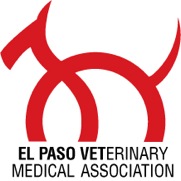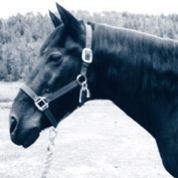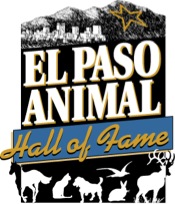
E P V M ANA N I M A LNH A L LNO FNF A M E
. . . . . . . . . . . . . . . . . . . . . . . . . . . . . . . . . . . . . . . . . . . . . . . . . . . . . . . . . .
M I S S I O NNS T A T E M E N T :
To honor those distinguished among the animal kingdom that
exemplify the strength and value of the human-animal bond;
To recognize the outstanding contributions
animals make to human lives in the El Paso community;
and to heighten public awareness of the human-animal bond.
Dwelling naturally in the desert or on a soft sofa, El Paso’s animals enrich El Pasoans’ lifestyles by sharing their lives, their talents, and their love. Whether saving a life, stopping crime, serving as a personal companion, performing for audiences, or educating the public, El Paso’s animals teach us about the importance of respecting all creatures and treasuring the time we spend together. Pets provide love, companionship, devotion and loyalty, enhancing the lives of their owners and the community in general. Man’s progress throughout the ages has been reliant on a myriad of benefits received from animals as helpmates and companions.
mmnTo recognize contributions made by El Paso’s animals, the El Paso Animal Hall of Fame (AHoF) was established in 1998. Big or small, short or tall, wild or domestic, furred or feathered, they deserve to be recognized and celebrated. Sponsored by the El Paso Veterinary Medical Association, Valley Feed/PETsBARN and the El Paso Zoo, the El Paso Animal Hall of Fame is housed at the El Paso Zoo, 4001 E. Paisano. This location allows the entire community as well as out-of-town visitors to learn about the great contributions animals have made to El Paso’s past and present.
mmnThe first recipient, Mona the Elephant, was chosen for her 40+ years as El Paso’s mascot of goodwill at the El Paso Zoo. She has delighted millions of children and adults demonstrating the natural elegance and charm of elephants.
{NClick here to download a PDF of the AHoF ApplicationN}
··········N2 0 2 2N··········
JUNO THE ELEPHANT
A rumbling, feisty, intelligent, expressive, sassy elephant . . .
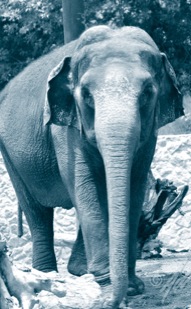
Juno the Asian elephant lived at the El Paso Zoo for 19 years. She was beloved and visited by thousands of El Pasoans. During her last 5 years, she developed a malignant mammary tumor and received treatments never before attempted in an elephant, which prolonged her life but could not cure the cancer. The El Paso community rallied around her in support, and Juno's keepers will always remember her spirit: A rumbling, feisty, intelligent, expressive, sassy elephant...
mmnOur beloved Juno gave all of us a greater sense of purpose. She always kept fighting and never gave up, and we never stopped believing in her and fighting for her, for her will to live. She never ceased to amaze us with all her trust in us, and we will never have a greater honor than being able to care for her. Her strength and bravery were only matched by the tremendous love we had for her. We can never truly put into words how special she was to us and to the elephant research and conservation world.
mmnJuno was a loving, brave soul. Our inspiration. Our warrior. Our Juno. We'll love her forever and always.
··········N2 0 1 9N··········
SUNNY THE SEA LION
Born and Raised at the El Paso Zoo
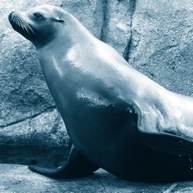
For the 26 years from 1986 to 2012, most visitors to the El Paso Zoo saw Sunny the California sea lion. Sunny was the first sea lion born and raised at the El Paso Zoo and for many years, he was the star of the zoo’s daily educational sea lion presentation. Multiple generations of El Paso children grew up visiting Sunny and asking for him by name.
mmnZoo educators reached 70,000 guests a year with important conservation messages about our oceans and recycling, because of Sunny’s charisma. Zoo visitors and keepers alike formed a special connection with Sunny. He was extraordinarily mild mannered and friendly, but mischievous enough to steal a bucket of fish if the opportunity arose. Sunny was a beloved and unique sea lion, who brought joy to tens of thousands of El Pasoans and visitors in his lifetime.
mmnThe California sea lion is a coastal eared seal native to western North America and is one of six species of sea lion. Its natural habitat ranges from southeast Alaska to central Mexico, including the Gulf of California, and feed on a number of species of fish and squid. Sea lions are particularly intelligent, can be trained to perform various tasks and display limited fear of humans if accustomed to them.
··········N2 0 1 3N··········
MWD CLEO J156, USMC (Ret.)
Specialized Search Dog
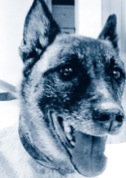
It is unknown how many American soldier lives heroic Marine Corps MWD (Military Working Dog) Cleo J156 saved during her two tours of duty in Iraq. Undoubtedly, there are many soldiers who have returned home to enjoy their todays and to contemplate their tomorrows because of Cleo’s expertise as a highly trained U.S. Marine Corps Specialized Search Dog (SSD).
mmnOf all the dogs used for explosive detection, the SSD is the supremely gifted expert. SSDs like MWD Cleo J156 work off-leash to search for arms, explosives and IEDs on roads and in open areas, buildings and vehicles. SSDs are outfitted with a harness which carries two walkie talkies allowing the K9s to work independently away from their handlers at distances up to 100 feet. The handlers give verbal commands to their highly trained K9 soldiers by both hand signals and by speaking through a headset attached to their helmet. SSDs reduce troop exposure and peril. An SSD team can clear a three story building in as little as four minutes, thus allowing troops to finish searching a neighborhood quickly with minimal risk for troop casualties.
mmnIn order to become an SSD, Cleo had to score 100% on all her certifying tests. In SSD Cleo’s world, failure in the field means certain death for American soldiers. During her six years of dedicated service, Cleo also had to maintain a 98% proficiency rating. Because of Cleo’s amazing capabilities, she was assigned to the Marine Expeditionary Force (MEF) at Camp LeJeune, North Carolina. Only outstanding, completely reliable, gifted dogs are assigned to a MEF unit as the whole unit could be called upon to deploy at a moment’s notice. These MWDs must consistently demonstrate their willingness to perform without distraction in spite of any adverse conditions or situations they may encounter.
mmnThroughout her six year career and during her approximately fourteen months of Operation Iraqi Freedom deployments, nine year old Cleo served flawlessly and admirably. Cleo daily put herself at risk to protect hundreds... maybe thousands... of soldiers by saving them from death with her amazing explosive detection abilities.
mmnThe life of a Military Working Dog is not easy, and the stress of Cleo’s many missions finally took their physical toll on her. In March 2010, Cleo was diagnosed with Cushing's Disease. The Department of Defense declared her “excess” and she was put up for adoption. The meds Cleo needed to stabilize the disease were extremely costly. As retiring MWDs receive NO medical benefits once their lives of military service have ended, nobody wanted to adopt this heroic life-saving dog. Ultimately, this hero would have faced euthanasia. Hearing of Cleo’s dire need, Debbie Kandoll and Louisa Vaughan of Military Working Dog Adoptions stepped up to arrange Cleo’s adoption and care. Through the compassion and generosity of Northeast Veterinary Clinic, Cleo’s complete cost of transport back to the Sun City was provided. U.S. Marine Corps MWD Cleo J156 found her forever home with the Kandolls in Las Cruces, NM.
mmnOnce a Marine, always a Marine... commitment never dies. Even in retirement, Cleo demonstrated her dedication to that ethos by weekly visiting her fellow soldiers at Ft. Bliss, TX who have PTSD and TBI. Whether they have two legs or four, soldiers relate to each other with complete understanding. For six years, MWD Cleo J156 manifested the USMC Core Values of Courage, Honor and Commitment. Though Cleo will always be best known for her explosive detection training, she will also be remembered for even higher levels of expertise in her detection abilities, as she became a “Heart Detector” in her efforts to help our two-legged soldiers recover from PTSD and TBI! But the Cushing’s impact worsened so much that beloved Cleo had to be euthanized this spring. Yet her spirit lives on in the legacy she and so many other K-9s who never make it back leave behind. Together they all exemplify the Marines—Semper Fi!
··········N2 0 1 1N··········
JOJO
Leading a Life of Love
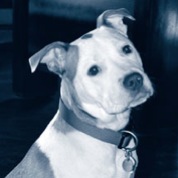
JoJo’s journey began, and nearly ended, as she lay by the side of the road hoping someone would stop to help her... but she was a feared, hated and misunderstood breed, so the hours and cars drifted by with no help. Finally, someone stopped and took her to the shelter in rural Texas. An examination revealed a severely broken leg in need of specialized surgical repair.
mmnThey wanted to give JoJo every chance possible. JoJo’s journey resumed when an orthopedic veterinarian 225 miles away in El Paso, Texas, Dr. Jim Koschmann from Crossroads Animal Hospital, agreed to do the surgery. From the Heart agreed to step in as her rescue for foster and rehabilitative care.
mmnJoJo’s journey continued when her foster mom, an occupational therapist, took JoJo to work so she could inspire humans recovering from orthopedic injuries. With a shaved hind leg, large rows of staples on her incisions and an external fixator sticking out of the top of her hip, JoJo went into service as a therapy dog to damaged humans, encouraging them to strive towards health.
mmnJoJo had her fixator removed and is progressing wonderfully with her own therapy. She continues to help the patients at the orthopedic hospital, demonstrating the loyalty and intelligence of her breed. But even more, she enjoys inspiring and giving love to people who are in pain, because she understands them.
mmnWith a record number of votes, she won the national ProPlan “Rally to Rescue” Rescue Dog of the Year. Now a registered service dog, her journey of love will continue for her lifetime.
··········N2 0 1 0N··········
ZULU
Heroic Lab-Mix Saves Beloved Master, Exemplifies Love & Loyalty
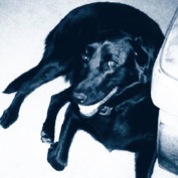
The morning of November 28, 2009, Robert Sumrall and his Labrador Retriever mix, Zulu, headed to New Mexico’s Gila Wilderness near Emory Pass for what was to be a routine day hike. Little did they know that their hike would turn into a life-threatening saga that tested every ounce of strength to survive bone chilling nights and days in the Gila's Black Range.
mmnSumrall parked his vehicle at Emory Pass near 8000-feet elevation and the pair headed south through Rustler's Canyon to an old mine. Bob’s map showed a trail that led from the mine to Iron Creek, but after looking for it for 45 minutes, the pair headed down and ended up in the rugged Bull Trap Canyon where huge boulders blocked their path. Bob picked up Zulu and tried to carry her through the barricade of rocks, but the pair slipped and fell into an icy pool of water and were drenched. As the afternoon sun slipped lower in the western sky, Sumrall knew that they would have to spend the night in the wilderness, both soaked and cold. The pair headed back up the canyon to reach higher ground as lowland canyons get extremely cold at night. Bob started a fire that night to stay warm and try to dry his clothes. He spent the night under a solar blanket, with the fire on one side and Zulu on the other side. The pair headed out again in the morning in hopes of finding their way out of their unexpected predicament.
mmnThe pair followed a horse trail that led to Little Gallinas Canyon, but as he walked he felt himself getting progressively weaker. Bob only had a few energy bars to share between the two of them, and his jeans, T-shirt and windbreaker didn’t provide much protection from the deteriorating weather conditions. As they continued down Little Gallinas, Bob heard some machinery noise, so they moved in that direction in hopes of finding civilization. By nightfall, the wind picked up and Bob couldn’t start a fire because of wet kindling and firewood. A severe winter storm moved into the region, dumping 10 inches of snow. Zulu and Bob curled up on the ground behind trees to stay out of the bitter wind and spent a miserable night trying to stay warm.
mmnThe next morning the exhausted pair followed a little road, crossed through two locked gates and came upon a small, locked cabin. He sat down on a lawn chair outside the cabin and tried to assess the situation. He used his .357 magnum pistol to shoot the locks on the cabin door. He was able to jar the door open enough to reach inside and get a small hatchet with which he chopped at the wooden door until he and Zulu could finally get inside. This is where Bob and Zulu spent their next three days in their weakened state. A cistern outside served as their water source while they shared their last energy bars. The cabin had a little wood stove, but Bob’s butane lighter quit working and he couldn’t find matches. The cabin’s interior felt like an ice box, but at least it kept them out of the wind and snow. Zulu never left Sumrall’s side as she continually nuzzled next to him. At night Bob slept on a sofa and Zulu slept on a throw rug as their bodies’ reserves slowly waned... minute-by-minute Bob’s body moved closer to coma and death. Hypothermia was setting in. Bob could hear search helicopters flying overhead, but he was too weak to get outside to attract their attention.
mmnOn their last morning delirium was setting in. Bob knew they needed water so they went outside, but they were too weak to travel. Once again the lawn chair looked inviting, so he laid down on it and lapsed into a coma-like state. Later that morning, local ranchers Melba and Tom Parra happened to come by the cabin as they were rounding up some of their cattle. The Parras saw Bob lying face-down in a dry, rocky wash just yards from the cabin, with Zulu lying on his back. The minute the Parras opened their truck doors, Zulu ran off and wouldn’t return to the scene. Bob was found in a state of delirium, suffering with hypothermia (body temperature of 81° F.), dehydration and mild frostbite. He was rushed to Silver City, NM and was then flown by helicopter to University Medical Center in El Paso for intensive medical care and extensive rehabilitation. Physicians believe Bob was within hours of dying, and the heat preserved by Zulu lying on him spared his life.
··········N2 0 0 8N··········
QUEENA
Heroic Pit Bull Mix Exemplifies Human-Animal Bond
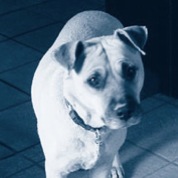
Tragedy shattered the lives of the Saldivar Family on October 22, 2007. An accidental fire ragingly engulfed their east El Paso home as pit bull mix Queena enjoyed the morning sun. Flames trapped her beloved 83-year-old invalid owner, Alfonso, who screamed for help from his room at the back of his brother’s home. Queena instantly sprang into action to try to rescue her master from the enveloped house. Firemen found Queena valiantly ripping at the back door in a desperate attempt to reach her favorite person. Hot tar dripping off the roof burned her nose, face, eyelids, ears and feet as Queena frantically clawed and chewed at the back door. While the fire escalated into an out-of-control inferno, its heat charred the fur on her head and back, melting her whiskers and eyelashes. News media reported that the fire was so intense, it melted some of the fire fighters’ helmets.
mmnQueena’s unyielding efforts to risk sacrificing her own life to save her elderly owner forced firemen to tie her away from danger, preventing more serious burns. Tragically, Mr. Saldivar succumbed to the fire that consumed much of the home as horrified family, neighbors and friends watched in disbelief, unable to do more.
mmnAuthorities rushed Queena to a local veterinary hospital to treat her burns while family members mourned the tremendous, unthinkable loss of their loved one. After veterinarians released Queena, From the Heart Rescue volunteers continued treating distraught Queena’s injuries. Their love and understanding eventually helped her overcome extreme shock and intense loss. They led her back to a meaningful life and new forever home with Alfonso’s family.
mmnQueena stands as a true animal hero. Her courageous efforts were in vain, but nevertheless she lives as a brave champion willing to suffer terribly painful burns in an attempt to save her beloved Alfonso. The human-animal bond soars with unconditional love and devotion in Queena’s story. She serves as another amazing example of why animal lovers gather each May during National Pet Week to honor the precious creatures that indescribably enrich our daily lives, and the people who care for them.
··········N2 0 0 7N··········
BARNABY JONES
Officer K-9-1 — El Paso Police Department’s First Commissioned Canine
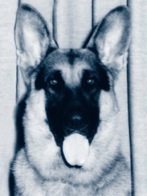
Since time eternal, man’s success relies on the assistance of animals, especially dogs. One of the most outstanding police canines, Barnaby Jones served six years as the first commissioned canine officer of the El Paso Police Department (EPPD), and another year after retiring from the force. His 1976 commission followed 16 weeks of intensive training and exceptional reviews in Baltimore to prep him for El Paso Officer K-9-1. Carefully selected for his supreme temperament, physical condition and breeding, Barnaby proved to be an excellent tracker. Named after the famous television detective portrayed by Buddy Ebsen, he received recognition from the actor himself, who acknowledged Barnaby's efforts by sending him a collar and dish with his name.
mmnThe El Paso K-9 pioneer could be as fierce as needed, persuading prisoners and suspects to surrender and comply with police orders with his daunting presence. His intelligence and advanced obedience training taught him to carefully subdue and hold prisoners, not to injure. Often, just the sight of a large, potentially threatening animal is enough to make force unnecessary. Together with handler, patrol partner and trainer Richard Edens, Barnaby Jones helped flush out burglars, sniff out stolen property and aided in narcotics/bomb searches. Canine units thrive across the nation based on early successes like Barnaby’s. They’re invaluable, economical, efficient assets in crowd control, emergency situations, officer protection, patrol back-up and arms/explosive/narcotics detection, among others. Called excellent deterrents, canine officers help maintain situations while saving wear and tear on police personnel.
mmnAn astounding performer, Barnaby Jones and his subsequent canine comrades can do more than a human and in less time, according to Edens, who wrote a research paper on K-9 effectiveness that helped convince the EPPD to incorporate the units. “Dogs do not rationalize like a person, and that makes people afraid of them. In most cases, a criminal will be more afraid of a dog than he would a policeman. A dog can do a job in 15 minutes that would take 100 men an entire day.”
mmnLiving together with Edens as constant companions, Barnaby Jones was all business on the job, but enjoyed family life like any other loved pet at home-enjoying attention and playing with children. Barnaby passed away in 1981 from arthritis complications and age-related ailments. He was nine years old, but his early legacy lives on in the El Paso Police Department's indispensable K-9 Unit that now totals more than 15 canine teams.
··········N2 0 0 6N··········
HUMPY THE ALLIGATOR
Desert Denizen and San Jacinto Plaza’s Witness to History
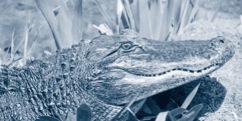
Transported in 1883 from Louisiana to Texas via the Texas & Pacific Railway, Humpy and five other alligators comprised a zoological gift to El Paso Mayor C.R. Morehead. The unusual desert denizens arrived in a cigar box, living in a whiskey barrel at the old Vault Saloon pending the construction of a special alligator pond in downtown’s San Jacinto Plaza. Humpy witnessed history, staring into the eyes of people from all walks of life including gunslingers, several American Presidents, Mexican Revolutionary Pancho Villa and U.S. General Blackjack Pershing.
mmnSeveral stories detail adventures of the aquatic reptilian cohorts. One narrative describes a weight-guessing contest with the winner receiving a whopping $100 and a trip to Mexico. In 1952, a 54-year-old female gator laid an egg in the pond. To the amusement of downtown spectators, the recumbent, protective mother-to-be sprang to life and rushed toward city employees who were trying to clean the fountain and pond. Also in ’52, someone smuggled one of the gators to Texas Western College (now UTEP), placing him in a professor’s office as a prank. Another time, people spotted one of the alligators swimming in the college pool before an intramural swim meet.
mmnAfter vandals blinded his left eye in 1965, Humpy moved to the safety and protection of the El Paso Zoo. His imposing size at 9 1/2 feet, 425 pounds and 100+ years of age made him one of the region’s most popular attractions until his quiet passing after cancer surgery in 1992. Humpy received a fitting burial next to another alligator pond at a local wildlife rehabilitation facility in Northeast El Paso, where a new generation of gators now finds peaceful refuge in El Paso’s desert Southwest. A memorial sculpture stands in the Plaza today as homage to the world famous alligator pond and its last stoic survivor, Humpy.
··········N2 0 0 5N··········
PUFFY LITTLE CLOUD
Internationally Renowned Weather Dog Sparkled Rain or Shine
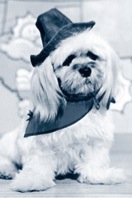
Sweet, precious and platinum with a wardrobe housing hundreds of hats and weather-oriented outfits, Puffy Little Cloud spent the late 1970s and early 1980s televising outdoor conditions for all of west Texas, southern New Mexico and northern Mexico. A Lhasa Apso puppy adopted at the Humane Society, Puffy soared into the national spotlight when she was the bridesmaid at the wedding ceremony of Howell Eurich and Gail Gordon, all of them part of KDBC-TV 4’s award-winning weather trio. The pampered weather pooch instantly became the subject of a National Enquirer feature with a four-color photo spread. Subsequently, a San Francisco news service sent out 2000 press releases to radio and TV stations nationwide, catapulting Puffy to celebrity status as El Paso’s own weather dog.
mmnEvery evening, KDBC-TV viewers raced to their TVs to watch Howell, Gail and Puffy do weather reports like no other station in the country. Donning everything from raincoats and slickers to stylish shades and snowsuits, Puffy and the forecasts garnered fame and fans around the world. Puffy received more than 50 pieces of mail daily, including a letter from international TV and movie star Benji, and a marriage proposal from Ernie, a love-lorn Shitzsu from England. The National Humane Society even nominated Puffy for a Patsy Award, the animal kingdom’s equivalent of the Oscar. Countless viewers created darling costumes tailored especially for Puffy in hopes of seeing their forecasting canine in the spiffy threads.
mmnWhen Howell and Gail had to leave town on business or vacation, Puffy would stay with Frank Jordan, the station’s director of engineering. Frank and Jean Jordan cared for Puffy as their own, but like all fame and fortune, it wasn’t going to last. Howell and Gail made the difficult decision to separate and eventually Gail left the Sun City. After Howell died tragically, Puffy was orphaned. However, with the permission of Howell’s kids and the Humane Society, the Jordans officially adopted Puffy, who began her leisure years as a house-hold family member, relinquishing the bright lights of stardom and tedious grooming for the appeal of warm beds, blankets, doggie doors and her new “brother” Bhutan, the Jordan’s other Lhasa Apso.
mmnPuffy lived out the rest of her life basking in the love of the Jordans in her new Upper Valley home, leaving a happy trail of meteorological memories and stellar forecasts in her wake. From pampered pooch and toast of the town to retired grand duchess and former sophisticate, Puffy served as a priceless goodwill mascot for El Paso’s hundreds of thousands of residents as well as a beacon of joy for all of her families.
··········N2 0 0 4N··········
MERCEDES THE HORSE
Extraordinary Educator and Wonderful Companion,
Mercedes Brought Glory of Black Army Regiments to Life
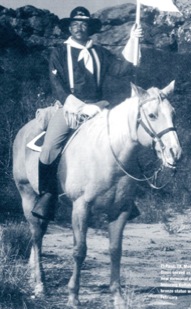
Written and televised history makes much ado about the courage and bravery demonstrated by the fighting, stabilizing units of the 19th Century U.S. Army. Yet, little regard is given to an often forgotten but critical aspect of that protecting force: the Buffalo Soldiers, fearless fighters of hostile groups who worked in virtually every other aspect of protection and service for more than 80 years.
mmnHighly revered by the Cheyenne who admired their strength, agility, fighting skills and compassion, they were dubbed the Buffalo Soldiers in honor of their culture’s staple, which was critical to their survival, and because of their similar revered traits. Refusing to forget their contributions and determined to generate awareness today, one man with a beloved horse vowed in 1998 to make sure the people he reaches are told about the Soldiers.
mmnUlysses Davis of El Paso, Texas, spends much of his free time dedicating his talents and personal resources to the history of the Buffalo Soldier. In the first years of reenactments, Davis rode his mare, Mercedes, and captured hearts everywhere they went. For more than three years, Davis, his family and the palomino quarter horse/thoroughbred caravaned nationwide to schools, rodeos, parades, fairs and special events sharing their living history presentation. From the Billy the Kid Days’ parade in Lincoln, New Mexico and El Paso’s 200-year-old cemetery Concordia for the “Walk Through History,” to the six-day-long “Last Great Cattle Drive of the Millennium,” Davis and Mercedes performed dozens of times annually.
mmnThese events gave them a chance to explain about the Soldiers and demonstrate their extensive contributions. Together they posed for historical statues, helped dedicate the new main facility of El Paso’s U.S. Post office, performed complex cavalry maneuvers and rode with the Governor of New Mexico.
mmn“It’s so important for people to understand the past,” said Davis. “Mercedes was an extraordinary educator, faithful companion and a tireless performer. She made an impact wherever we went. Many people will now remember who the Buffalo Soldiers were because of their exposure to Mercedes. It’s important to our culture, our heritage and to the real history of America.”
mmnAfter succumbing to colic in 2000, Mercedes was honored by horse lovers and the community who raised and donated hundreds of dollars for Mercedes’ vet bills. Today Davis and the thoroughbred Lincoln continue Mercedes’ legacy to spread the word about the American Buffalo Soldiers.
··········N2 0 0 3N··········
EDIE “SUM HOPE”
Companion Canine Extraordinaire
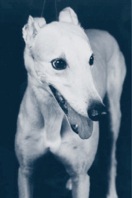
Only animal lovers understand the profound effect that companion pets have on the lives of their family members.
mmnRescued by the Greyhound Adoption League as a retired racer with a less than stellar performance record, “Sum Hope” (her track name) was reborn in 1997 to her new mom, Diane Stowe, as Edie (her call name). In her first year of domestic life, the female, fawn colored canine didn’t know how much impact her track name would have on her human family.
mmnDiane had heard that retired racing greyhounds make excellent pets in spite of the sad lives many of them endure on the racing circuit. Like other former racers, she was exceedingly thin with a bare bottom from excessive crating. In addition to a furred friend, Diane was seeking a partner for outdoor pursuits, especially walking. Together they exercised faithfully, building strength and emerging fit and healthy while making friends everywhere they went. Edie more than lived up to her breed’s reputation as a well behaved, beloved pet.
mmnHowever, those breezy days soon ended, with Edie’s patient manner and track name put to the real test. Shortly after the holidays, Diane’s husband, Jim, was diagnosed with cancer. They were quickly overwhelmed with countless physician visits, radiation treatments and operations. Heartbroken with worry and grief, the rising medical bills, household expenses and never-ending phone calls exhausted them.
mmnIn hopes of finding a way to sort through the confusion and mess, Diane placed Edie’s comforter next to her desk. Not only did she develop a system to deal with the mounting piles of paperwork, she had a true companion to lift her spirits and offer hope even on the darkest days. However, her husband’s condition continued to worsen, with the cancer surgery leaving him badly disfigured and blind in one eye. When he returned home, Edie brought calm, acceptance and unconditional love to everyone. She immediately recognized him, head bandages and all. Through her devotion and acceptance, she made it clear she was there to help him recover and heal, remaining vigilant by his side, yet anxiously awaiting Diane’s return from work. Edie is the first to greet their day and the last to settle down for the night.
mmnWhen Edie runs for fun in the yard or park, Diane says it makes her heart leap with delight. As she claps and encourages her, she speeds into a blur, flashing into something quite magical and divine—celebrating the joy of being alive. For a dog that wasn’t fast enough for the racetrack, she gave her family “Sum Hope” for the most important race of all—the human one.
mmnEdie continues to astound her family with her understanding, intelligence and beauty, reminding them to live each day to the fullest, one moment at a time. Edie taught her family to realize that all good things take time, including the healing of the heart, body and soul. Despite the many challenges her family has faced, Edie’s loving presence has shown them how to be grateful for all their blessings and to remember the real key to happiness—to always have “Sum Hope.”
··········N2 0 0 2N··········
JUSTICE
U.S. Customs Service Narcotic Detector Dog
(Posthumously Recognized)
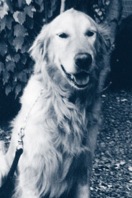
To protect and to serve on America’s Frontline. It’s a motto not only for law enforcement, but for the canines trained to detect illegal drugs. A 75-pound Golden Retriever, Justice spent seven years working with U.S. Customs Service Canine Enforcement inspectors at El Paso ports of entry and cargo lots. A vital part of Customs’ anti-smuggling program, Justice helped inspectors stop thousands of pounds of narcotics from entering the United States, while the “evidence” helped federal prosecutors convict countless felons.
mmnThrough Justice, the general public gained a greater understanding of the role the U.S. Customs Service plays in border enforcement, and the special contributions of its canines—the dogs with jobs. Out of about 60 drug sniffing dogs employed by the U.S. Customs Service at the El Paso port of entry, Justice received the “Top Dog” honor from 1996 until his retirement in May 1998, when he was named the agency’s National Dog of the Month.
mmnRescued as a puppy from the pound’s death row to star in Chuck Wagon dog food TV commercials, Justice was recruited for his intelligence and even temper to join the Customs Canine Enforcement ranks. He spent 12 weeks in Front Royal, Virginia, training to alert handlers of narcotics presence. Trained in positive response, Justice participated in more than 130 drug seizures, resulting in the confiscation of more than 6,180 pounds of marijuana, 380 pounds of cocaine and 2.5 pounds of heroin. Contraband of this magnitude easily exceeds a street value of more than $10 million-drugs that did not make it to the schools, playgrounds and neighborhoods of El Paso.
mmnIn addition to profiles in numerous national and international newspaper and television stories about Customs Canines, he appeared in a 1991 nationally broadcast story on drug sniffing dogs that aired on ABC’s World News Tonight with Peter Jennings and was regularly featured in local media stories focusing on border drug intervention. Justice often demonstrated his abilities before thousands of school children in “Just Say No to Drugs” campaigns, as well as to adults at civic group meetings, regional trade fairs and conventions. He also drew attention to the remarkable efforts of the Customs Canine Enforcement Branch by participating in Red Ribbon Week and El Paso Thanksgiving parades and other community events.
mmnFollowing his retirement with honors, Justice enjoyed the life of leisure with the family of his handler, Supervisory Canine Enforcement Officer Roberto “Bobby” Hernandez. After four years spent reflecting on his career stopping bad guys at the border, Justice died a few months ago knowing that he left the world a far better place than the one that planned to destroy the once homeless puppy. He leaves a lasting legacy of the incalculable worth of thousands of animals available for adoption every year at El Paso area humane and rescue organizations. Justice proved that with proper love and the right training, the rewards are boundless—and people can make a friend for life.
··········N2 0 0 1N··········
PEARL THE HORSE
(Posthumously Recognized)
Grade. Part quarter horse, part draft horse. To the hundreds of riders and volunteers who Pearl served at Therapeutic Horsemanship of El Paso, that means Grade A.
mmnPearl spent 15 years working New Mexico trails, carrying hunters and campers through the wilderness and assisting in search and rescue missions. He even saved a drowning mule or two. His consistent strength and steadiness marked his long history of reliable gentleness and remarkable unspookability.
mmnWith his strong back, sure footing and supreme nature, Pearl retired from the Gila and began his next career with Therapeutic Horsemanship. For more than 10 years, he provided Hippotherapy, recreational riding and horsemanship services to the area’s disabled children and adults at a therapy facility and camps for special needs children. He also participated in parades, equestrian shows and Special Olympics.
mmnThe dedication and commitment to his job that Pearl demonstrated each day, year round, allowed the emotionally and physically disabled to receive the unique benefits that can only be found through therapeutic riding. Pearl patiently addressed the challenges of his unusual work to provide high quality therapy services.
mmnMaintaining the requested stride and gait necessary for the rider on the trail, Pearl played games with moving and stationary objects while carrying the rider through an obstacle course. He performed the often difficult maneuvers required at shows and special events with little or confusing direction from the rider or leader.
mmnHe was often on the move, traveling well to many equestrian centers and trails while cooperating with other horses to perform and provide therapy services. Regardless of the physical or behavioral difficulties or discomfort the rider may be experiencing that may not allow him/her to respond appropriately, Pearl always recognized and greeted the rider with affection. He instilled in them a sense of confidence, well being and self-esteem by always cooperating and performing for riders, staff and volunteers. He carried first place winners in the Southwest Quarter Horse Association Open Shows and served in annual camps for El Paso Candlelighters, Jewish Community Center and El Paso Diabetes Association.
mmnPearl possessed a patient and reliant attitude even under the sometimes stressful conditions that befall the therapy horse: delayed feeding time; heat and cold; trailer-travel to unfamiliar arenas and trails; handling by new and different volunteers and riders, tack, riding equipment and therapy tools; standing patiently for long periods so that a disabled rider may mount, possibly from a wheelchair or with a crowd of volunteers, instructors and therapists.
mmnIt was all taken in stride as part of his job. With these ever-changing conditions, Pearl once reflected on his long successful career:
“As a therapy horse, I had the privilege of carrying the most special load there is.
Just moving these old legs at a walk or a trot around the arena or down the trail gave these special
boys and girls a chance to gain their own independence and get the therapy they needed while
having a great time. It was hard work for all of us to help these riders get the most out of their ride,
but it was good work and I am proud to have called myself a therapy horse.”
—PEARL
··········N2 0 0 0N··········
CLANCY
The Life Saving Boxer
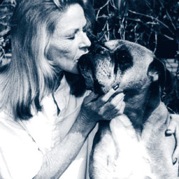
Clancy the fawn-colored Boxer knew he could lose his own life when he raced to the rescue of his beloved mistress, Carrol Bella, in 1991. He remembered the severe injuries he received years earlier in another mountain lion attack.
mmnAs federally licensed wildlife rehabilitators, Charles “Cheeter” and Carrol Bella care for injured and orphaned animals in their Northeast El Paso compound. For almost 30 years they’ve understood the risk involved in dealing with black bears, alligators, wolves and big cats, to name a few. During routine care one brisk fall day, Carrol was feeding and watering a large, mature mountain lion named Chief when she left to answer the phone. The cage door failed to completely latch and Chief was suddenly free. Waiting in a predatory crouch for unsuspecting Carrol’s return, Chief leapt for Carrol’s throat.
mmnInstinctively she turned her right shoulder to the raging lion. The impact’s weight and velocity knocked Carrol to the ground while Chief’s powerful jaws drove his fangs through several layers of sweatshirts and T-shirts into her shoulder’s flesh. Gnawing on her, she lay helplessly pinned and screaming while a nearby pet Rottweiler retreated, yelping and hiding in terror.
mmnThat’s when Clancy sprang to Carrol’s rescue, shoving the lion off her chest and biting him back. As Chief released his death grip, Carrol had a fleeting moment to scramble away and find help from Cheeter, working in his shop nearby.
mmnTogether the Bellas returned to the scene, where Clancy maintained a hold on Chief, yet his eyes were glazing from sheer exhaustion. Managing to get Chief back to his cage, the Bellas focused on Carrol’s hemorrhaging shoulder. After administering stitches, followed by weeks of antibiotics and countless bandage changes, physicians marveled at Carrol’s recovery. Without Clancy’s heroic intervention, she would have died.
mmnClancy succumbed to bone cancer in his cervical spine in 1997, leaving the Bellas heartbroken but blessed for sharing part of their lives with him. True animal heroes are a rare find. Clancy’s story illustrates the crucial role companion animals play in our daily lives. The El Paso Animal Hall of Fame proudly recognizes Clancy for his heroic acts committed out of unconditional love and desperate need to protect his family at all costs. He remains alive in the loving hearts of all who knew him.
··········N1 9 9 9N··········
CHARLIE
Beloved Mascot, The David L. Carrasco Job Corps Center
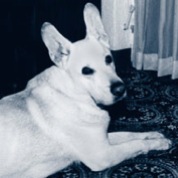
Charlie, a pure white German shepherd mix, dedicated 11 years of his life to the love and support of staff and disadvantaged youth enrolled in the Job Corps programs. Officially adopted as Center Mascot on Sept. 21, 1985, Charlie became a significant part of Center life. His abusive history prior to joining the Center served as a weekly symbol to the Orientation class. His story was told to new students, who compared the cutting of the large chain that had embedded itself under the flesh of Charlie’s neck, to whatever obstacles had hindered the realization of the student's full potential.
mmnSuffering from malnutrition, occult heartworm disease and a rampant infection from the heavy choke chain, Charlie was discovered tied to a tree by neighbor and Center Director David L. Carrasco. After several failed attempts to get help for Charlie’s failing condition from his neglectful owner, Carrasco cut the chain himself and sought veterinary help. Twenty stitches later, he was able to keep the large, lucky dog. The Center’s Government Association immediately and unanimously adopted Charlie.
mmnThe most needy of the Center’s student population gravitated to membership in the Charlie Club, which was responsible for all aspects of his care. Student relationships with Charlie proved invaluable in developing their full potential. They related to Charlie, who like them came from the school of hard knocks. If no one else could break through, Charlie would bring out their soft side. When young men came in acting tough, staff left them with Charlie. If they started petting him, they knew the student would make it.
mmnConsidering he was the mascot for an educational institution, Charlie attended and graduated third in his class at Animal House Obedience School. He became a media darling with highly publicized commemorations of his Job Corps anniversaries as well as many other Center events he attended, including basketball games, parades, visits to nursing homes and elderly shut-ins as well as Center-produced stage productions.
mmnLike many of the Center’s students, the almost fatally injured dog overcame his obstacles and transformed into a happy, healthy, star attraction at Job Corps. On October 1, 1996, Charlie left his extended Job Corps family, a victim of crippling arthritis of the spine. He is buried on the Center’s athletic field, his favorite place to run.
mmnCharlie is still an on-going legacy at Job Corps. A returning and now highly successful student recently looked around the office Charlie shared with Carrasco and said, “There is only one thing missing from this picture... and that’s Charlie. He was here to welcome me to the Center and he should be on that couch now as I leave.”
mmnThe El Paso Animal Hall of Fame proudly recognizes Charlie for his countless contributions that enriched the lives of thousands of El Pasoans. He remains alive in the loving hearts of all who knew him.
··········N1 9 9 8N··········
MONA THE ELEPHANT
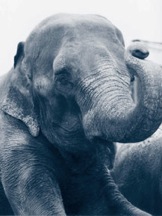
Since 1956, Mona has been the top featured educational attraction as the mascot of goodwill at the El Paso Zoo. Millions of El Pasoans and out-of-town visitors learn about the natural elegance and charm of elephants by watching Mona’s 20+ commands and behaviors.
mmnVoted one of Texas’ Top Billed Beasts in the June 1990 issue of Texas Monthly, Mona celebrates her 47th birthday this year. At four tons, she’s never been bred and is too mature to start now.
mmnHer new home in the recently unveiled Asian Exhibit gives Mona (an Asian elephant) seven times the space of her former digs, with 48,000 sq.ft., two yards (one as an exhibit and one for exercise/workouts) and access to an eight-foot deep pool for relaxation and swimming.
mmnWith relatively poor eye-sight and hearing, elephants have very thick skin that’s sensitive to insect bites and the sun. That’s why they bathe themselves in dirt or sand to provide sun and insect protection. With one-finger trunks, Asians can perform a variety of tasks, from hauling logs to picking up quarters off the ground. They can live up to 80 years, but lifespans depend on teeth. When sets of teeth are used up, elephants starve to death.
mmnAsian ears, smaller than African ears, work like air conditioners with an intricate network of blood vessels running close to the surface. By flapping they can cool the blood supply, and themselves.
mmnAbout 15,000 endangered Asian elephants remain in the wild. Sought for the ivory tusks of males, the elephants are rapidly losing their habitat to man. Conservation efforts and breeding programs in zoos have led to great success in raising young Asian elephants in captivity.
mmnThe El Paso Animal Hall of Fame proudly recognizes Mona for her countless contributions that enrich the lives of El Pasoans and our visitors.


